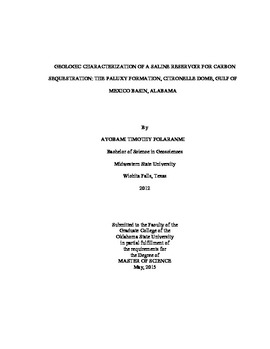| dc.contributor.advisor | Pashin, Jack C. | |
| dc.contributor.author | Folaranmi, Ayobami Timothy | |
| dc.date.accessioned | 2016-09-29T18:34:01Z | |
| dc.date.available | 2016-09-29T18:34:01Z | |
| dc.date.issued | 2015-05-01 | |
| dc.identifier.uri | https://hdl.handle.net/11244/45164 | |
| dc.description.abstract | The purpose of this study is to characterize a saline formation that is actively being used to store CO2 as part of the SECARB III Anthropogenic test in Citronelle Field in southwest Alabama. The study is designed to understand the potential of the Paluxy Formation in Citronelle Field to store commercial quantities of anthropogenic CO2. This entails detailed analysis of core data and geophysical logs from three recently drilled wells in the Southeast Citronelle Oil Unit. The field is developed in the crestal region of Citronelle Dome, which is a simple salt-cored anticline that lacks faults and contains abundant reservoir sandstone bodies and mudstone, evaporite, and carbonate seals.The Paluxy has an average thickness of about 1,100 ft in Citronelle Dome. Sedimentologic analysis indicates that the Paluxy Formation was deposited in a fluvial environment that included bedload-dominated fluvial systems and interfluvial paleosols. The Paluxy Formation is a coarsening-upward, succession composed of numerous stacked, aggradational sandstone-mudstone packages. Individual sandstone bodies have sharp bases, typically fine upward, and range in thickness from less than 10 ft to more than 40 ft. Although some sandstone units have great lateral continuity, each well may have substantially different geophysical log signatures, reflecting internal reservoir heterogeneity among wells.Analysis of cores and geophysical logs was performed to determine framework sandstone composition, sandstone diagenesis, and reservoir architecture. Results show that the sandstone units are predominantly arkosic. Porosity and permeability are well-developed in the sandstone especially in the Upper Paluxy, where average porosity and permeability values are 19 percent and 200 mD respectively. Intergranular pores predominate, and intragranular pores are common within feldspar grains. Quartz is the most abundant authigenic cement and is expressed primarily as overgrowths; pore-filling calcite and ferroan dolomite also are common. Authigenic clay includes grain-coating illite and pore-filling kaolinite. An understanding of reservoir composition and the formative depositional and diagenetic factors will provide a predictive framework to help facilitate field-scale commercialization of anthropogenic CO2 storage. | |
| dc.format | application/pdf | |
| dc.language | en_US | |
| dc.rights | Copyright is held by the author who has granted the Oklahoma State University Library the non-exclusive right to share this material in its institutional repository. Contact Digital Library Services at lib-dls@okstate.edu or 405-744-9161 for the permission policy on the use, reproduction or distribution of this material. | |
| dc.title | Geologic Characterization of a Saline Reservoir for Carbon Sequestration: The Paluxy Formation, Citronelle Dome, Gulf of Mexico Basin, Alabama | |
| dc.type | text | |
| dc.contributor.committeeMember | Hileman, Mary | |
| dc.contributor.committeeMember | Donoghue, Joseph F. | |
| osu.filename | Folaranmi_okstate_0664M_14004.pdf | |
| osu.accesstype | Open Access | |
| dc.description.department | Geology | |
| dc.type.genre | Thesis | |
